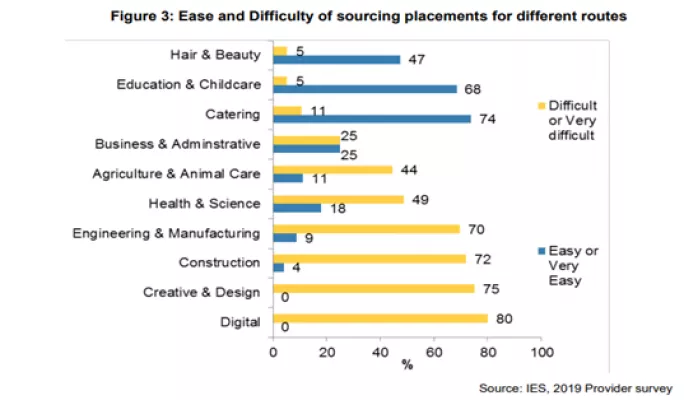
T levels placement problem needs a robust response

As the government confirms plans for the technical and vocational landscape of the future, one of the big questions is around the capacity of England plc to deliver on the number of placements that will be needed through the full-scale rollout of T levels from 2024.
The rollout of T levels is arguably one of the biggest shake-ups that has post-16 education ever witnessed. The government’s overarching aim is to provide gateway qualifications to post-18 study in a wide range of technical skills, which will help meet the need for skilled technicians and provide a credible alternative to a three-year degree. In other words, it is about putting technical education on the map and supporting the levelling up agenda.
T levels are two-year technical study programmes equivalent to three A levels. Industry placements are one of the key unique selling points. While all students on a current study programme should have the opportunity of two weeks of work experience and some programmes already require substantial placements such as early years/childcare, T levels take this to a whole new level. Each T-level student requires an industry placement of a minimum of 45 days to achieve their T level. This initiative brings England in line with other technical vocational education systems such as Finland and the Netherlands, where extended placements are commonplace.
Btecs: DfE to finally announce level 3 reforms
More: T-level employers to get £1K per placement
Background: Just 12 per cent of employers aware of T-level qualifications
Colleges across the country have been piloting industry placements through the capacity and delivery fund (CDF) since 2018. And yet it needs to be remembered that the maximum number of extended placements that colleges have had to find to date has been for up to 25 per cent of their cohort, and this has been interrupted for the past two college years by the pandemic.
T levels: The challenge of finding enough industry placements
Student feedback speaks to their value in building confidence, learning new skills and consolidating skills learned at college, finding out more about the industry of their choice and feeling empowered. This is what we would want for all students and, indeed, will need in order for them to be able to achieve a T level, but will it be possible? And especially as we gradually emerge from the pandemic.
Throughout the pilots, the government has commissioned a number of reports on placements gaining the perspectives of both business and colleges. The July 2020 evaluation of support for industry placements provides a helpful overview of the benefits and challenges of placements.
Employers
While those employers that have engaged with placements were generally positive and saw the benefits of being able to shape the future talent pipeline, others were more cautious. Capacity, and the time to supervise a student; the extended length of the placement; lack of appropriate space/equipment; lack of relevant work or bad timing; and bad prior experience working with young people or educational providers were all cited as concerns.
Colleges
The evaluation report notes that for every placement sourced, 43 per cent of providers said they were in contact with between zero and four employers; 22 per cent with between five and nine employers; and 15 per cent between 10 and 14 employers.
“These figures demonstrate the significant resource providers were required to mobilise in order to source their target numbers of placements.”
The challenge differs between sectors, too. It is easier to find placements in catering, education and childcare and hair and beauty, as opportunities exist in all towns, cities and even rural areas. Creative, design, engineering and manufacturing and digital are the most difficult.

A further challenge is the myriad asks made of employers; apprenticeships, traineeships, Kickstart, mentoring, site visits, work experience for schools, colleges and universities competing in large towns and cities or challenged by poor rural infrastructure, such as lack of public transport in more remote locations.
If T levels are to be the key technical qualification offer at level 3 to meet the skills gaps, provide a valued and recognised alternative to HE and if we really want to offer a high-quality placement experience for as many students as wish to take them, wherever they are based, from Cornwall to Northumberland, via London, Birmingham and Manchester, the challenges above need to be addressed. This needs to be done in line with the scale of placements required by 2024 and beyond.
Short-term incentives and support for employers are not to be dismissed, but this challenge needs something more significant, sustainable and workable and it needs to come from the top. If government wants colleges to deliver the skills required by employers, it needs to actively encourage, perhaps even mandate those same employers to get involved. It also needs to consider regional and sector-by-sector planning and brokerage. The Netherlands, for example, has a web page dedicated to supporting matching students. A wicked challenge requires a robust response. Employers - your colleges need you!
Catherine Sezen is a senior policy manager at the Association of Colleges
You need a Tes subscription to read this article
Subscribe now to read this article and get other subscriber-only content:
- Unlimited access to all Tes magazine content
- Exclusive subscriber-only stories
- Award-winning email newsletters
- Unlimited access to all Tes magazine content
- Exclusive subscriber-only stories
- Award-winning email newsletters
You need a subscription to read this article
Subscribe now to read this article and get other subscriber-only content, including:
- Unlimited access to all Tes magazine content
- Exclusive subscriber-only stories
- Award-winning email newsletters
- Unlimited access to all Tes magazine content
- Exclusive subscriber-only stories
- Award-winning email newsletters